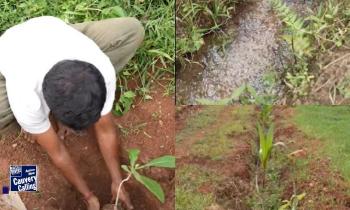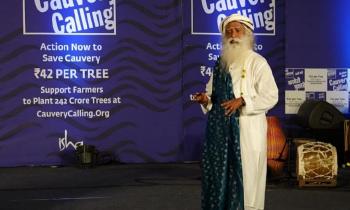Karnataka can become a model state in the practice of tree-based agriculture
About 44% of the land under agriculture in the State has soil with low or very low available water capacity (AWC). Growing annual cereal agricultural crops in such areas is not sustainable and will lead to further land degradation, says Dipak Sarmah, ex-PCCF (Govt. of Karnataka).

This is Part 2 of the two-part series on the Role of Agroforestry in Forest Conservation and Agricultural Development. Read Part 1.
One significant aspect regarding the distribution of forests of Karnataka is that most forests are concentrated in the Western Ghats region where almost 45% of the geographical area is covered with forest, whereas it is about 12% in the interior Karnataka region and about 8% in the eastern plains. The proportion of open agricultural lands under cereal crops in these three regions are about 44%, 74% and 81% respectively. The abysmally low distribution of forests in interior Karnataka and the eastern plains which comprise more than two-thirds of the State’s geographical area is a matter of concern, as vast expanses of open agricultural lands without adequate tree cover in the vicinity do not augur well for the long-term health of the agricultural lands.
It is difficult to indicate as to what ought to be the ideal proportion of agricultural land under cereal crop. However, given that the National Forest Policy, 1988 envisages a minimum of one-third of the total land area of the country under forest or tree cover and considering that certain portions of the land have to be necessarily earmarked for other forms of land-use such as built-up areas, water bodies, etc., the land under cereal crop ought to be at the most 55-60% of the geographical area of the country/State. The extent of land area brought under cereal crop in the interior Karnataka region and the eastern plains is as high as 75-80%. In a few districts such as Gadag, Vijayapura, Kalaburagi and Yadgiri, it is almost 90%.
It is necessary to appreciate that having vast expanses of open agricultural land with only cereal crop without any tree growth or wood-lot can be environmentally unsustainable and highly counterproductive, especially in the rain deficient and drought-prone areas such as the interior Karnataka and the eastern plains. There is a need for increased appreciation among the farming community regarding the contribution of forest or tree cover to the sustainability of agriculture and food security. The urge to expand agriculture is so intense that any land having tree growth is often treated as an unnecessary appendage and is eliminated without much concern or forethought. It is necessary to dispel this misconception and make people aware of the positive role of forest/trees in agricultural development. Maintenance of forest cover on the land helps in restoring soil fertility leading to increased yield of agricultural crops.
Trees improve soils by many processes such as production and maintenance of organic matter, nitrogen fixation, nutrient recycling, augmentation of nutrient uptake, etc. The contributions of forest or tree cover are very diverse: on one hand it ensures protective environmental functions such as maintenance and restoration of soil fertility, erosion control, soil and moisture conservation and maintenance of biodiversity. On the other, it assists in direct food production, provision of fuelwood, fodder and inputs for agriculture as well as generation of income and creation of rural employment. The benefits accruing from forest or tree cover either enhance agricultural production and food availability or increase the ability of people to purchase adequate food supplies.
There is one more reason why agro-forestry needs to be given a further push in the State. About forty-four percent areas of the State currently under agriculture have soils with low or very low available water capacity (AWC) (SoER Karnataka-2015). Growing of annual cereal agricultural crops in such areas is not sustainable and will lead to further land degradation. Such areas need to be brought under perennial tree crops under agro-forestry, besides dry-land horticulture and sericulture (tree-mulberry). These activities will also help in drought-proofing the vulnerable agricultural lands.
In view of what has been narrated above and considering the beneficial effects of agro-forestry on the long-term health of agricultural land, there is a need for enhanced focus on agro-forestry by both the Agriculture and the Forest Departments. The Agriculture Department already has a fairly robust extension wing which should be taken advantage of to its optimum potential in furthering the cause of agro-forestry. The Forest Department needs to strengthen its extension efforts in encouraging farmers to take up tree planting in their farmlands. The Department has already taken an important step in this direction. To enlist the co-operation of farmers and the general public in the task of increasing forest and tree cover, a program titled ‘Krishi Aranya Protsaha Yojane (KAPY)’ has been initiated in the State. As per the program, farmers are provided seedlings at subsidized rates from the nearest Departmental nurseries for planting in their lands. The farmers are paid an amount of Rs 30 as an incentive for every surviving seedling at the end of the first year. A sum of Rs 30 and Rs 40 per seedling is provided for each surviving seedling after completion of second and third year respectively. The incentive is given to encourage the farmer not only to plant the seedling but also to nurture it at least for three years. The total amount of money provided (Rs 100/- per seedling) more than compensates the cost incurred by the farmer in procuring and planting the seedling. The incentive is quite substantial when the farmer plants more number of seedlings. Needless to say that apart from getting the financial incentive, the farmers are entitled to get handsome returns from the grown-up trees in various forms such as fruits, seeds, fodder, firewood, pole, timber, etc.
In the interior Karnataka region and the eastern plains, the ‘Krishi Aranya Protsaha Yojane’ should be the flagship program of the Forest Department both in terms of attention and investment. Availability of biomass and generation of additional income through farm forestry will reduce people’s dependence on the natural forests. Such reduction of biotic pressures on our natural forests will be conducive to their rejuvenation and the Department’s efforts at restoring these forests to their original glory will be more effective.
While raising seedlings for planting under agro-forestry programs, farmers’ choice and preference need to be given the utmost importance. Focus should be more on woody tree species yielding annually harvestable produce such as oilseeds, fruits, flowers, medicine, gum, etc. Short rotation tree species such as silver oak (Grevillea robusta), hebbevu (Melia dubia), etc. should be encouraged. Wherever possible, bevu (Azadirachta indica), karijali (Acacia nilotica), honge (Pongamia pinnata), bage (Albizzia lebbek), teak (Tectona grandis), sandalwood (Santalumalbum), mahogany (Swietenia macrophylla) and bamboo should be propagated. Most of the woody trees usually provide certain quantity of fuel wood by way of natural pruning.
In Karnataka, sericulture is a prominent activity and vast extents of land are planted with mulberry. In recent years, tree-mulberry has become popular, as its leaf production is reported to be as good as that from ordinary mulberry crop. Therefore, tree-mulberry should be encouraged in agro-forestry. Trees like bevu (Azadirachta indica), honge (Pongamia pinnata), etc. attract swarms of honey bees; therefore, bee-keeping should also be encouraged. Agro-forestry including dry-land horticulture generates huge quantities of biomass in the form of leaf-litter. Part of this biomass can contribute to development of organic farming. Vermi-composting is another option. By planting fodder yielding trees and high yielding fodder grasses, fodder production can be increased within the farmland, thereby helping in improved animal husbandry practices.
Overall, agro-forestry can immensely contribute to development of viable and robust integrated farming systems (IFS). Cauvery Calling, which promotes this sustainable farming practice, will benefit the farmers of Karnataka and will contribute to the soil and water health of the region.
The author, Dipak Sarmah, is a retired IFS officer who served as the Principal Chief Conservator of Forests (PCCF), Govt. of Karnataka. He may be contacted at sarmahdipak1@gmail.com











